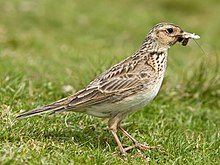
Back Alauda arvensis AN قبرة الغيط Arabic قبرة الغيط ARZ Alauda arvensis AST Һабан турғайы Bashkir Cīrolis BAT-SMG Жаўрук палявы Byelorussian Полска чучулига Bulgarian Alc'hweder sant Pêr Breton Alosa eurasiàtica Catalan
| Eurasian skylark | |
|---|---|

| |
| With insect caught in beak | |
| Song recorded in Wales | |
| Scientific classification | |
| Domain: | Eukaryota |
| Kingdom: | Animalia |
| Phylum: | Chordata |
| Class: | Aves |
| Order: | Passeriformes |
| Family: | Alaudidae |
| Genus: | Alauda |
| Species: | A. arvensis
|
| Binomial name | |
| Alauda arvensis | |
| Subspecies | |
|
See text | |

| |
| Range of A. arvensis Breeding Resident Passage Non-breeding Extant & Introduced (resident) Possible extinct & Introduced
| |
The Eurasian skylark (Alauda arvensis) is a passerine bird in the lark family, Alaudidae. It is a widespread species found across Europe and the Palearctic with introduced populations in Australia, New Zealand and on the Hawaiian Islands. It is a bird of open farmland and heath, known for the song of the male, which is delivered in hovering flight from heights of 50 to 100 metres (160 to 330 ft). The sexes are alike. It is streaked greyish-brown above and on the breast and has a buff-white belly.
The female Eurasian skylark builds an open nest in a shallow depression on open ground well away from trees, bushes and hedges. She lays three to five eggs which she incubates for around 11 days. The chicks are fed by both parents but leave the nest after eight to ten days, well before they can fly. They scatter and hide in the vegetation but continue to be fed by the parents until they can fly at 18 to 20 days of age. Nests are subject to high predation rates by larger birds and small mammals. The parents can have several broods in a single season.
- ^ BirdLife International (2018). "Alauda arvensis". IUCN Red List of Threatened Species. 2018: e.T102998555A132039889. doi:10.2305/IUCN.UK.2018-2.RLTS.T102998555A132039889.en. Retrieved 12 November 2021.
